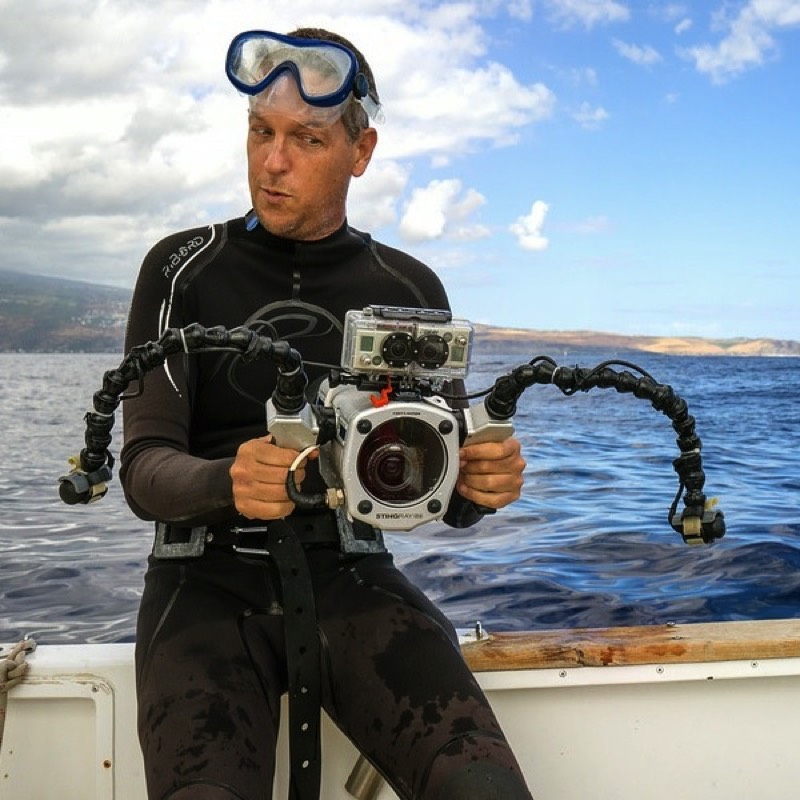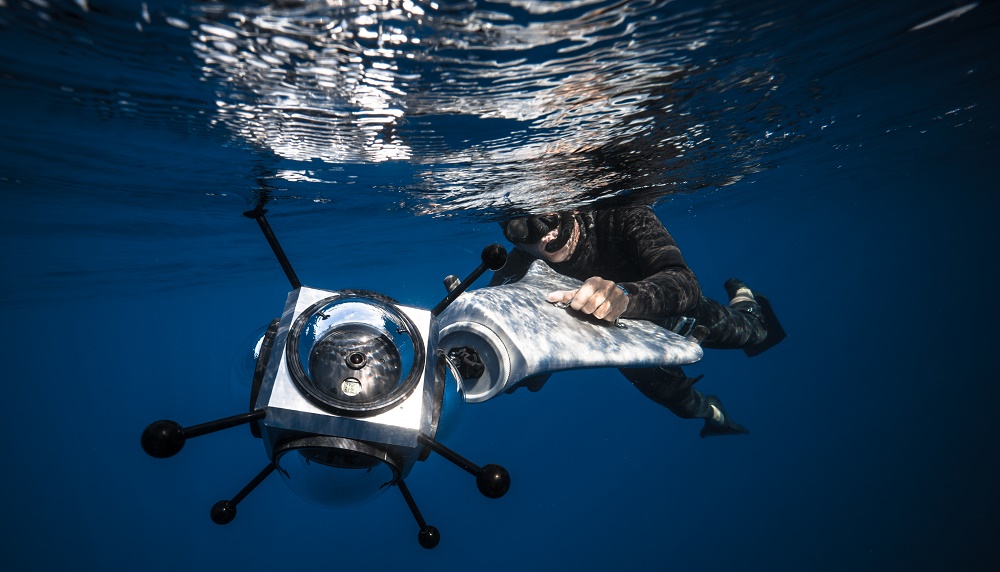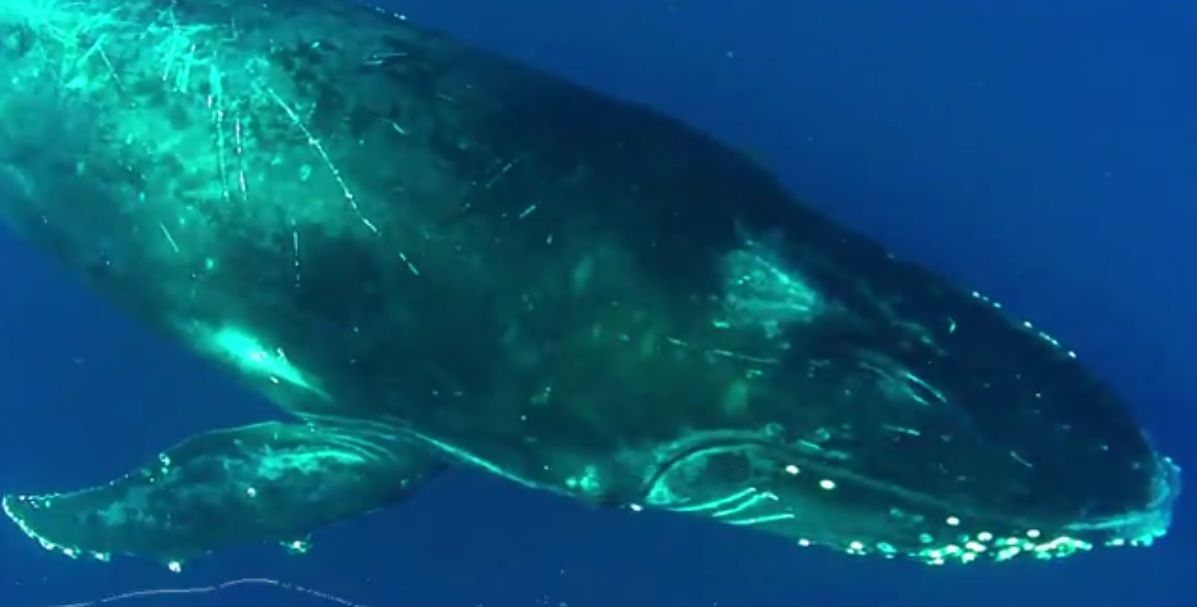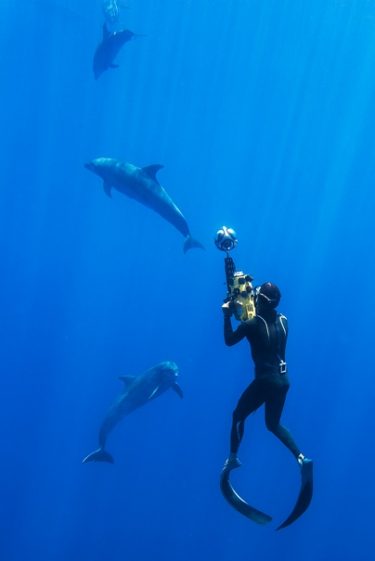Fabrice Schnoller is a French biologist and free diver based on the island of La Reunion. He’s the founder of Darewin.org and a key player in The Click Effect, a virtual reality wildlife documentary filmed in collaboration with The New York Times in an effort to help us better understand dolphins and whales.
How did you get into this amazing line of work?
Ten years ago, I had an experience that changed my life: I met 20 sperm whales, all in a pod. Although sperm whales can eat sharks and they could kill us quite easily– they are predators, after all – they are actually very gentle.
They’ve been hunted by humans for over 30 years, and they are so far away from us because they live in waters of large depths, so they are hard to contact. Plus, they live 70% of their life in total darkness, so we are very disconnected. But when I met them face to face, there was something in their eyes, something not like other animals. They are strong and smart.
They are more interested than stressed by your presence, so just stay calm and let them come to you. If they are fighting among themselves there might be some tension but when they accept you, they just do everything as normal around you. I once saw a pilot whale attack a baby sperm whale. They are very powerful. And they fight to kill – but they don’t even look at you.
What happens when you meet a dolphin or whale?
It’s difficult to understand but it must be the miracle of fascination: they with us and not just us we with them. For example, one dolphin was very interested in the camera. He just wanted to understand what was going on and he was pushing us to see because he was very interested. It was very cool.
It begs the question, what is intelligence? Is it ability to adapt to the environment? Is it skill with technology? For me, it’s curiosity and the want to ask questions. When they see me take off my fins, for them it’s like taking off a foot! So they are trying to learn and interact.
You imitate their sounds, their whistle. In the communication protocol for humans, there are alternative sounds and we tend to need to look at the person we’re talking to. For example, I would say, “Hi Simon, it’s Fabrice.” I use your name, then my name, like with a walkie-talkie.
Whales first sound out their ID, as if they were introducing themselves. Then, because the communication sound comes in a focused and narrow beam, it’s clear to know who they are talking to.
So how do whales and dolphins communicate?
It’s like they have a recording antenna; their teeth act as the equivalent of a receiver or microphone. For us, you need to see how the sound is created underwater and you need to work out who is vocalizing the sound.
In a single pod, you may have up to 20 dolphins talking, so the first question is which one is making the sound, and the second is who they are talking to, and the third is what they are saying.

Dolphins don’t use the same communication protocols as humans. We use quite elementary parts of speech, known as phonemes [one of the units of sound that distinguishes one word from another]. Humans are slow; we transmit info at about 30bps [bytes per second; for comparison, Netflix HD streaming uses about 4000 bps].
With dolphins, they get the information into the sound. It’s very ‘tinny’ – similar to the noise your old dial-up modem used to make – and it has 3D information; this opens the door to a more efficient way of communication.
In the ocean, there is a lot of noise, and so a lot of data to gather. We needed to recreate situations to try to find proof. We needed to meet with the animals and hope that they would talk. Sometimes they would talk for minutes, sometimes hours. But to be able to prove it, we needed three to four years to convince the scientific community.
So your virtual reality (VR) tours helped here?
A good way to convince people is through the incredible experience of VR and augmented reality (AR). You get to ‘live’ the experience. You get to whistle a dolphin’s name and see them react, so there’s an emotional understanding. We imagine that once a million people have experienced this, it will be faster to convince the community.

We started VR tours seven years ago, using cameras and software we created ourselves – we were ‘doing VR before VR existed’. We needed to get all the info underwater in all directions, because with a normal camera, 80% of all information is lost.
Then about three years ago, people started to become interested and started to invest in what we were doing already. The New York Times approached us and the projects started coming.
What are your plans for the future?
We’re trying to build technology that is compact enough to produce a high-quality signal while still being suitable for a free diver to carry. We’re looking for partners to help make prototypes.
I find it amazing that we can send things to the moon but not manage very well underwater on our own planet. We’ve been to the moon a half-dozen times, but to the bottom of the ocean? Zero.
How does this fit into the larger picture of the world’s health?
By 2050, we will potentially have killed nearly everything in the sea, through overfishing.
We hope that virtual reality movies will make people stop and make discoveries and change their behaviour.
With vocal interactions with dolphins and whales, this should open the door to more understanding.
Why not talk to dolphins? Probably because it’s not “politically incorrect”, or rather it’s taboo: we’re killing the planet and we don’t want to think about it.
Google is working on immortality at the moment, but my opinion is, we have to focus on the well-being of existing creatures. The best way to do this is to focus on emotional connections and empathy.
Change is good, even if it happens in 10, or 50 or even 100 years. These experiences with dolphins will stay in our minds forever; it’s the easiest way to change our behaviour.
To save everything, all we have to do is make 40% of the world’s oceans a sanctuary.
It’s terrible what’s happening in the sea, and yet it’s not the top of our priorities because global warming and oil are. But this is urgent; in 30 years, it may be too late. This is not a projection; it’s been shown that we are killing 5% of the oceans’ wildlife every year. All we need to do is eat half as much fish as we do now.
I’m not a vegetarian. Maybe more importantly, dolphins are not vegetarian. But all of humanity needs to become 50% ‘more vegetarian’. We need to slow down our consumption, not accelerate it as is happening at the moment.
The “ambassadors of the animal kingdom”
The world moves in phases. In the 19th century, we saw the end of slavery and the introduction of democracy. What is the next big step for us? In my opinion, it will be rights for animals. I think 200 years from now, people will see that this was the obvious thing to do – and they will think that we were barbarians until the day that this changed.
Let’s start with whales and dolphins, and move on to big apes and elephants. These are all social and sentient and smart beings. They aren’t just part of the ecosystem, they are like us. Dolphins are just the start. They are the ambassadors for the animal kingdom and they are going to help us change the way we behave.
More information from Fabrice:
To learn more, visit darewin.org. Or watch the video below:
"ExpatGo welcomes and encourages comments, input, and divergent opinions. However, we kindly request that you use suitable language in your comments, and refrain from any sort of personal attack, hate speech, or disparaging rhetoric. Comments not in line with this are subject to removal from the site. "

























